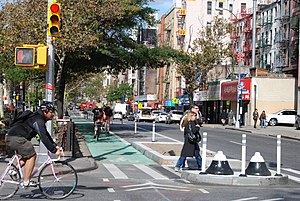
There is debate over the safety implications of cycling infrastructure (e.g. cycle tracks, protected intersections). Recent studies generally affirm that segregated cycle tracks have a better safety record between intersections than cycling on major roads in traffic.[1] Furthermore, cycling infrastructure tends to lead to more people cycling. A higher modal share of people cycling is correlated with lower incidences of cyclist fatalities, leading to a "safety in numbers" effect though some contributors caution against this hypothesis.[2][3] On the contrary, older studies tended to come to negative conclusions about mid-block cycle track safety.[4][5][6][7]
However, the implications for road safety of cycle tracks at intersections is disputed. Studies generally show an increase in collisions at junctions, especially where cyclists are travelling in the direction opposite to the flow of traffic (e.g. on two-way cycle tracks). Protected intersection designs generally improve safety records over non-protected junction types.[1][8]
A 2006 report by the National Cooperative Highway Research Program in the US concludes that "bicycle safety data are difficult to analyze, mostly because bicycle trip data (and thus accident probability per trip) are hard to uncover".[9] One major reason for the inability to draw definite conclusion may be that facilities with different risks are often categorized together so that off-road paths – paved or unpaved, bicycle-only or multi-use – were lumped together, as found by research at the Cycling in Cities program at the University of British Columbia.[10]
- ^ a b Reynolds, Conor CO; Harris, M Anne; Teschke, Kay; Cripton, Peter A; Winters, Meghan (21 October 2009). "The impact of transportation infrastructure on bicycling injuries and crashes: a review of the literature". Environmental Health. 8 (1): 47. Bibcode:2009EnvHe...8...47R. doi:10.1186/1476-069x-8-47. ISSN 1476-069X. PMC 2776010. PMID 19845962.
- ^ Cite error: The named reference
:3was invoked but never defined (see the help page). - ^ Bhatia, Rajiv; Wier, Megan (1 January 2011). ""Safety in Numbers" re-examined: Can we make valid or practical inferences from available evidence?". Accident Analysis & Prevention. 43 (1): 235–240. doi:10.1016/j.aap.2010.08.015. ISSN 0001-4575. PMID 21094319.
- ^ Cite error: The named reference
:4was invoked but never defined (see the help page). - ^ Cite error: The named reference
:1was invoked but never defined (see the help page). - ^ Cite error: The named reference
:5was invoked but never defined (see the help page). - ^ Cite error: The named reference
:6was invoked but never defined (see the help page). - ^ Zangenehpour, Sohail; Strauss, Jillian; Miranda-Moreno, Luis F.; Saunier, Nicolas (1 January 2016). "Are signalized intersections with cycle tracks safer? A case–control study based on automated surrogate safety analysis using video data". Accident Analysis & Prevention. 86: 161–172. doi:10.1016/j.aap.2015.10.025. ISSN 0001-4575. PMID 26562673.
- ^ NCHRP Report 552, 2006, "Guidelines for Analysis of Investment in Bicycle Facilities", National Cooperative Highway Research Program, Transportation research Board of the National Academies, page F-1
- ^ Reynolds, Conor CO; Harris, M; Teschke, Kay; Cripton, Peter A; Winters, Meghan (2009). "The impact of transportation infrastructure on bicycling injuries and crashes: A review of the literature". Environmental Health. 8 (1): 47. Bibcode:2009EnvHe...8...47R. doi:10.1186/1476-069X-8-47. PMC 2776010. PMID 19845962.
© MMXXIII Rich X Search. We shall prevail. All rights reserved. Rich X Search
